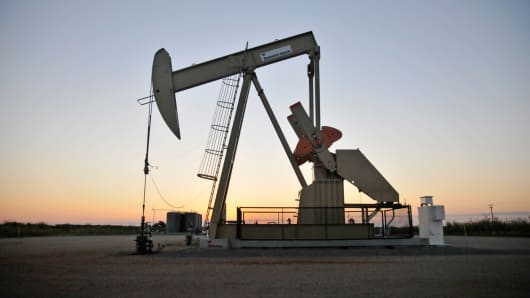Page added on November 27, 2015
Oil prices have moved into ‘super contango’

In a recent report, the International Energy Agency highlighted the fact that global inventories of all petroleum products were at 3 billion barrels, which was a record. And just over 2 billion of those barrels are resident here in the U.S.
Each week, in the summary page of its petroleum-status report, the U.S. Energy Information Administration references the fact that U.S. crude-oil inventories are at levels not seen in over 80 years. Inventories of gasoline are well-above their average and diesel fuels are also well-supplied.
The vast crude oil glut or mega-glut is manifest in the West Texas Intermediate and Brent crude oil price curves, which have moved into a “super-contango.” (Yup, there are lots of superlatives needed to describe the current state of the market.)
Contango refers to when the front-month or near-term futures contract are trading less than or at a discount to longer-dated futures contracts.
The difference between Brent crude-oil contracts, one year apart, recently hit a record $8 a barrel. The January 2016 WTI futures contract is trading at a hefty discount of $1.50 per barrel to the February contract. In tightly-supplied markets, when crude oil prices are strong, that spread value is the complete opposite.
Oil prices have gotten some support this week from the heightened military action and worry over the situation in Syria and Northern Iraq, especially with the downing of the Russian fighter jet by Turkey. How Russia responds could plunge the region into deeper turmoil, putting a great deal of oil infrastructure and supply in the cross hairs. But these fears simply do not haunt the market for very long last these days.
The market also got a taste of Saudi Arabia‘s power this week, when a flip comment by the Saudi oil minister at a cabinet meeting was taken to signal a change in production policy by the Kingdom, as a way of “cooperating” with the other OPEC and non-OPEC producers. With the OPEC meeting looming next week, the comments were seized upon.
The reality is that nothing will come of the OPEC meeting. The Saudis are set to hold their ground. They see little to gain in assisting their oil market and regional rivals, Russia and Iran, by helping to “stabilize” the oil markets. In fact, the Saudis don’t see a market that needs stabilizing.
The lone bright spot for the oil market has been the strong demand for gasoline. The demand in October in the U.S. was the highest in eight years. But, once the holidays pass, that demand will drop off, too.
The downward pressure remains intense on the petroleum complex from the mega-glut and the hit to demand from the economic softness in China and Europe. The strengthening dollar is also a negative for prices.
U.S. motorists will be filled with glee this holiday season, as they buy sub-$2.00 per gallon gasoline, courtesy of $30 crude oil.
6 Comments on "Oil prices have moved into ‘super contango’"


Plantagenet on Fri, 27th Nov 2015 1:14 pm
As the oil glut moves into its second year, oil prices are set to move even lower. The low prices should help to boost demand (US driving miles just hit an all time high, for instance) and eventually demand will rise to meet the supply and the glut will end.
But it hasn’t ended yet.
Cheers!
penury on Fri, 27th Nov 2015 5:33 pm
Plant, I really hope that your analysis is correct, However; I still think that economics will prevail and the price of gasoline for the American driver will approach world parity in the longer term. War is not a good way to increase your economy regardless of what Dr.Krugman advocates.
Plantagenet on Fri, 27th Nov 2015 5:46 pm
Hi penury: What do you think is world parity for gasoline prices? In Venezuela its currently about 8 cents a gallon (2 cents per liter), while in Libya (which obama liberated in 2011) sells gasoline for 56 cents a gallon and Iraq (which Bush liberated in 2003 sells gasoline for $3.50 gallon. Meanwhile gasoline in Saudi Arabia is about 64 cents a gallon.
http://www.globalpetrolprices.com/gasoline_prices/
I agree with you 100%—-We are going to see much higher gasoline prices in the USA soon enough no matter what ding dongs like Paul Krugman say.
cheers!
twocats on Fri, 27th Nov 2015 11:27 pm
the longer the low oil price the better. once it ends, and it will end within a year (95%) or two (99.7%), which wild-cat speculator is going to want to pick up that road kill? will the majors even want to bother with such tight margins? can the ponzi be revived? meh, until then, happy motoring!!
GregT on Sat, 28th Nov 2015 12:08 am
“What do you think is world parity for gasoline prices?”
Obviously that would be the average planter. Higher for those experiencing low prices, and lower for those experiencing higher prices. According to your link above, that would be $1.01 US/litre, or $3.82 per US gallon.
Cheers!
shortonoil on Sat, 28th Nov 2015 10:13 am
Crude prices have moved down faster than our energy Model indicated that they would. That does not imply that they will continue down at the same rate that has been witnessed over the last 22 months:
http://www.thehillsgroup.org/depletion2_022.htm
“As an industry, we’re at the point where every dollar of free cash flow now goes to paying back debt,”
http://www.zerohedge.com/news/2015-11-27/cusp-staggering-default-wave-energy-intelligence-issues-apocalyptic-warning-energy-s
To cover cash requirements producers have been maximizing production to increase their cash flow. This has been driving prices down even further. Prices can, however, only decline until producers can no longer cover lifting costs; at that point their cash flow goes from positive to negative if they continue to produce. It becomes, from the cash flow perspective, more important to reduce production, rather than to increase it.
Lifting costs, for the average 4,000 foot well with a 50% water cut, will average between $20 and $25 dollars per barrel. For wells with 90%+ water cuts costs will approach $40. The average well now being pumped in the US, according to EPA figures, has a water cut of about 90%. The price point where it becomes more cost effective to reduce production than increase it will begin when the price no longer covers the lifting cost of the average well.
Taking into consideration the full production life cycle of petroleum, most producers are now losing money on every barrel that they produce. They are failing to replace reserves that they are now extracting, and the difference between the two must be considered an expense. When fields now being produced have become fully depleted without replacement the operations will cease. Merely taking cash flow into consideration in no way gives an accurate projection of the overall condition of the industry.
http://www.thehillsgroup.org/